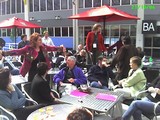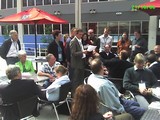Blog
Subscribe
Join over 5,000 people who receive the Anecdotally newsletter—and receive our free ebook Character Trumps Credentials.
Categories
- Anecdotes
- Business storytelling
- Collaboration
- Communication
- Corporate Storytelling
- Culture
- Decision-making
- Employee Engagement
- Events
- Fun
- Insight
- Leadership Posts
- News
- Podcast
- Selling
- Strategy
Archives
- March 2024
- December 2023
- November 2023
- October 2023
- September 2023
- August 2023
- July 2023
- June 2023
- May 2023
- April 2023
Years
Facilitating a workshop of 90 futurists
 Last week I faciliated a workshop of 90 futurist gathered together for The Australian Foresight Conference. The organisers were keen to harness the energy created by the conference to explore new ways the group might collaborate into the future. With 90 people in a large atrium I was keen for the group to learn about themselves as a whole and go beyond an intellectual understanding. With Andrew’s help we designed a 90 minute session which included sociometry and getting people to vote with their feet. Here is what we did and a few things we learned from the process
Last week I faciliated a workshop of 90 futurist gathered together for The Australian Foresight Conference. The organisers were keen to harness the energy created by the conference to explore new ways the group might collaborate into the future. With 90 people in a large atrium I was keen for the group to learn about themselves as a whole and go beyond an intellectual understanding. With Andrew’s help we designed a 90 minute session which included sociometry and getting people to vote with their feet. Here is what we did and a few things we learned from the process
We divided the session into two parts: understanding where the group was now; and exploring possible future collaboration opportunities. This session tool place about 2/3rds of the way though a three day conference. To kick things off I got everyone to stand and ask them to arrange themselves along an imaginery 20m line. One end of the line represented those people who thought this was one of the best conferences they had ever attended; a transformational event. The other end was for those people that thought the conference really sucked. With lots of laughter and chatting the group arranged itself pretty evenly along the line. I asked everyone to have a good look around at the result.
Using the same approach I then asked people to indicate the level of foresight experience they have with one end representing over 30 years (2 people) and the other end for those people just starting out. This time there were more people in the middle and the ‘just starting out’ end of the spectrum. Based on the movement from the previous question, it seemed like the people ‘just starting out’ were enjoying the conference more that the highly experienced practitioners.
The previous two questions where aimed at getting people used to moving around and learning about the whole group. My last question was directed squarely at the objective of the session: please indicate your level of comfort and preference for using technology to collaborate. One end represented those people who loved using technology and the other consisting of people who would rather avoid it eschewing even the telephone. Again, an even spread.
We then moved to creating a human social network diagram and I asked everyone to think about the time before the conference and recall those people they regularly collaborated with. Then stand next to a collaborator and place your hand on their shoulder. Within a few minutes a complex network of bodies emerged with clear clusters evident. I asked people to look around and then invited people from each cluster to describe their bunch.
The next step was to explore the potential for new collaborations, so I asked the group to think about the people they’ve met at the conference and who they would like to collaborate with in the future. Again I invited everyone to place their hand on the shoulder of potential future collaborators. The network changed considerably suggesting a substantial potential for new connections and collaborations.
 At this point I asked everyone to grab a seat. The tables were arranged in groups of eight. To get people to consider what collaboration meant to them I ask each group to have a conversation and explore the question “why do you collaborate?” This discussion went for 15 minutes and was simply designed to get people to think about collaboration generally.
At this point I asked everyone to grab a seat. The tables were arranged in groups of eight. To get people to consider what collaboration meant to them I ask each group to have a conversation and explore the question “why do you collaborate?” This discussion went for 15 minutes and was simply designed to get people to think about collaboration generally.
We wanted to move from this understanding of the reasons for collaboration to different forms it might take, so I invited the whole group to construct a final spectrum but this time with one person on the spectrum line representing a form of collaboration. The group made suggestions. At one end of the spectrum was formal approaches to collaboration while the other end represented informal approaches. The suggested structures, from formal to informal, were: association, community of practice, salon, virtual collaborators, partnerships, mentoring, adhoc collaborations. A addtional group formed calling themselves ‘the walkers’ and they paced up and down the entire spectrum highlighting that all the structures were relevant and useful.
Now that we had some structures identified I asked people to join a group that appealed to them most and for each group to develop a description of why their structure would be best suited for everyone to adopt. Each group then had a representative spruke the benefits of their approach. As the final move of the session I ask people to make a decision as to which group they would like to move to after hearing each benefits statement. This final group then develop a mini action plan on what they would do next to make progress after the conference finished.
The session seemed to be enjoyed by the group and the organisers were pleased with the outcomes. Lots of good actions and a commirement by people to take the next steps. One of the interesting things for me was how quickly strong groups formed and how strongly people identified with their chosen group. For example, in summarising the session I forgot to mention the Salon group and an indignant Salon member quickly pointed out that they had a very productive session and didn’t feel compelled to join any other group.
About Shawn Callahan
Shawn, author of Putting Stories to Work, is one of the world's leading business storytelling consultants. He helps executive teams find and tell the story of their strategy. When he is not working on strategy communication, Shawn is helping leaders find and tell business stories to engage, to influence and to inspire. Shawn works with Global 1000 companies including Shell, IBM, SAP, Bayer, Microsoft & Danone. Connect with Shawn on:
Comments
Comments are closed.
Thanks for running the session Shawn. I thought it went really well.
My constructive feedback:
Thought the sociometry of collaborating networks was really good – and that this could have been explored a bit more. Perhaps instead put your hands on the shoulder of two people here who you have collaborated most with and see how people try to get close to those two people. Would be lots of interesting jostling.
The why collaborate exercise I thought was a bit long.
Finally, the groups were quite competitive and seemingly non-collaborative. Identity was formed within each group but it would have been interesting to have tried to draw some more common threads between the various groups – some difference is still good though to gt different actions arising.
Thanks again …
Luke
Thanks Luke. Great suggestions. Always room to improve 🙂